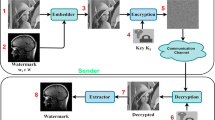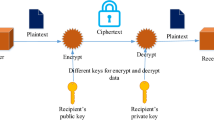Abstract
Reversible Data hiding techniques reduce transmission cost as secret data is embedded into a cover image without increasing its size in such a way that at the receiving end, both secret data and the cover image can be extracted and recovered, respectively, to their original form. To further reduce the transmission cost, the secret data can be embedded in the compression codes by some popular reversible data hiding schemes. One of the popular and important reversible data hiding method is high- performance data-hiding Lempel–Ziv–Welch (HPDH-LZW) scheme which hides the secret data in LZW codes. In this paper, the HPDH-LZW scheme is modified in order to increase its hiding capacity and compression ratio. First, the proposed work modifies the Move to Front (MTF) encoding technique to hide the secret data and also to increase the similarity among the element of the cover media. Then, LZW encoding technique is applied on the resultant cover data to obtain LZW codes, which are used to hide further secret data. Experimental results show that the proposed scheme has significantly increased the data hiding capacity and have good embedding and extraction speed in comparison to other state of the art schemes.









Similar content being viewed by others
References
Aabed MA, Awaideh SM, Rahman MEA, Gutub A (2007) Arabic diacritics based steganography. In: Intl. Conference on Signal Processing and Communications, IEEE, p 756–759
Bentley J, Sleator D, Tarjan R, Wei VA (1986) Locally adaptive data compression scheme. Commun ACM 29:320–330
Chang C, Kieu TD (2010) A reversible data hiding scheme using complementary embedding strategy. Inf Sci 180:3045–3058
Chang C, Lin CY (2007) Reversible steganographic method using SMVQ approach based on declustering. Inf Sci 177:1796–1805
Chang C, Lu TC (2006) Reversible index-domain information hiding scheme based on side-match vector quantization. J Syst Softw 79:1120–1129
Chang CC, Tai WL, Lin CC (2006) A reversible data hiding scheme based on side match vector quantization. IEEE Trans Circuits Syst Video Technol 16(10):1301–1308
Chang CC, Lee CF, Chuang LY (2009) Embedding secret binary message using locally adaptive data compression coding. International Journal of Computer Sciences and Engineering Systems 3:55–61
Chang CC, Huynh NT, Wang YK, Liu Y (2018) An improved data hiding method based on Lempel-Ziv-Welch compression code. International Journal of Network Security 20(3):478–488
Chen, CC, Chang, CC (2010) High-capacity reversible data-hiding for LZW codes. In: International Conference on Computer Modeling and Simulation, IEEE, p 3–8
Guo JM, Tsai JJ (2012) Reversible data hiding in low complexity and high quality compression scheme. Digital Signal Process 22(5):776–785
Gutub A, Fattani M (2007) A novel arabic text steganography method using letter points and extensions. In: International Conference on Computer, Information and Systems Science and Engineering, IEEE, p 28–31
Haidari FA, Gutub A, Kahsah KA, Hamodi J (2008) Improving security and capacity for arabic text steganography using ‘Kashida’ extensions. In: International Conference on Computer Systems and Applications, IEEE, p 396–399
Hong W (2018) Efficient data hiding based on block truncation coding using pixel pair matching technique. Symmetry 10(36):1–18
Kumar R, Chand S (2017) A novel high capacity reversible data hiding scheme based on pixel intensity segmentation. Multimed Tools Appl 76(1):979–996
Kumar A, Pooja K (2010) Steganography-a data hiding technique. Int J Comput Appl 9(7):19–23
Kumar R, Malik A, Singh S, Kumar B, Chand S (2016) Reversible data hiding scheme for LZW codes using even-odd embedding strategy. In: International Conference on Computing, Communication and Automation (ICCCA2016), IEEE, p 1399-1403
Kumar R, Chand S, Singh S (2018) A reversible high capacity data hiding scheme using combinatorial strategy. International Journal of Multimedia Intelligence and Security 3(2):146–161
Li B, Ni G, Luo J, Zhang X (2011) BWT-based data preprocessing for LZW. International Conference on Multimedia and Signal Processing. https://doi.org/10.1109/CMSP.2011.16
Malik A, Sikka G, Verma HK (2016) A high payload data hiding scheme based on modified AMBTC technique. Multimed Tools Appl 76(12):14151–14167
Malik A, Kumar R, Singh S (2016) Reversible data hiding scheme for LZW codes using LSB flipping strategy. AICTC '16, ACM, p 1-5
Qin C, Zhang X (2015) Effective reversible data hiding in encrypted image with privacy protection for image content. J Vis Commun Image Represent 31:154–164
Shim HJ, Ahn J, Jeon B (2004) DH-LZW: lossless data hiding in LZW compression. In: International Conference on Image Processing, IEEE, p 2195–2198
Sindhuja J, Anitha B (2016) An approach for lossless data hiding using LZW codes. International Journal of Emerging Technology in Computer Science & Electronics (IJETCSE) 20(2):172–176
Wang ZH, Yang HR, Cheng TF, Chang CC (2013) A high-performance reversible data-hiding scheme for LZW codes. J Syst Softw 86:2771–2778
Xue Y, Tan Y, Liang C, Zhang CY, Zheng J (2018) An optimized data hiding scheme for deflate codes. Soft Comput 22(13):4445–4455
Yang B, Schmucker M, Funk W, Brush C, Sun C (2011) Integer DCT-based reversible watermarking for images using companding technique. Int J Electron Commun 65:814–826
Zhao W, Yang B, Gong S, Li X (2016) An Improved reversible data-hiding scheme for LZW codes. In: International Conference on Computer Engineering, Information Science & Application Technology (ICCIA 2016), IEEE, p 150-155
Author information
Authors and Affiliations
Corresponding author
Additional information
Publisher’s note
Springer Nature remains neutral with regard to jurisdictional claims in published maps and institutional affiliations.
Rights and permissions
About this article
Cite this article
Kumar, R., Chand, S. & Singh, S. An optimal high capacity reversible data hiding scheme using move to front coding for LZW codes. Multimed Tools Appl 78, 22977–23001 (2019). https://doi.org/10.1007/s11042-019-7640-2
Received:
Revised:
Accepted:
Published:
Issue Date:
DOI: https://doi.org/10.1007/s11042-019-7640-2




